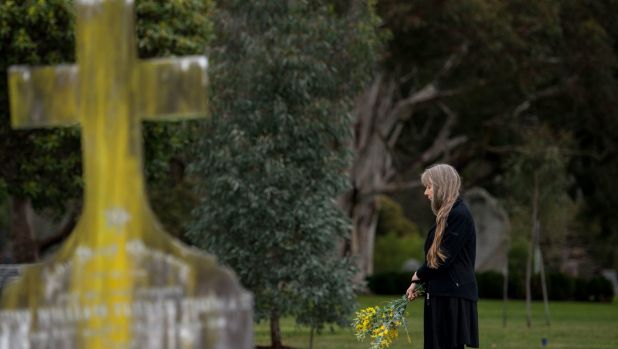Lucy Sussex, a literary historian, novellist and a long-time member of Sisters in Crime, has solved the mystery of where pioneering crime writer, Mary Fortune, is buried. Jason Steger, The Age’s literary editor, reports: (Courtesy of Fairfax Media.)
Sometimes the biggest mysteries have the simplest solutions. That’s certainly the truth in the case of the resting place of pioneering crime writer Mary Fortune. For many years it has been a case of the lady vanishes.
Now Lucy Sussex, biographer of Fergus Hume and long-time champion of Fortune and her work, has discovered the unmarked grave where she has lain since 1911.
Lucy Sussex at the unmarked grave of writer Mary Fortune at the Springvale Cemetery. Photo: Penny Stephens
Fortune was one of the first writers of police procedurals and between 1868 and 1908 wrote more than 500 stories for The Australian Journal. But she used a pseudonym, W.W., standing for Waif Wander, and her identity was revealed only in the 1950s.
Fortune had a turbulent life that included a spell when she first arrived in Australia on the Victorian goldfields, a bigamous marriage, an illegitimate child, drunkenness and vagrancy. “She was said to be the only truly bohemian woman writer in Melbourne in that era.”
Sussex says that as more material was digitised, more information turned up. She discovered that Fortune was writing much later and more frequently than had been thought.
“In 1910 she turned up in the census in the Benevolent Asylum, a charitable institution, and their records are held at the State Library. She was admitted because she was going blind and she was there until October 1910.”
As Fortune didn’t appear in subsequent censuses or electoral rolls, Sussex worked out she had died in 1911. She found her grave by simply searching for her names Mary and Helen, which threw up a misspelling that had thwarted researchers for years – her surname in the Springvale Cemetery records was spelt with a double-f. As Hercule Poirot said, “it is the brain, the little grey cells on which one must rely”.
The importance of discovering the grave, Sussex said, depended on how you regarded memorials. “It might be that for Sisters in Crime (which promotes women’s crime writing) it becomes a locus for Australian writing.”
Sussex said Fortune could be considered the mother of Australian crime writing and she was the most unusual among women writers of the time because she wrote from the viewpoint of a police detective.
“She was writing from what she knew, what she’d seen of the police on the goldfields. She’s extremely good, but because she wrote so much she can be extremely bad as well. A lot of people really like her autobiographical journalism because it’s very lively. Goldfield historians love her memoirs.”
Note: More than two decades ago, Lucy Sussex also tracked down the unmarked grave of Ellen Davitt who wrote Australia first full-length crime novel, Force or Fraud, in 1865. In 1994, Sisters in Crime organised for Davitt’s distant relative, UK novelist Joanna Trollope, to put a plaque on the grave in the Geelong Cemetery. In 2001, it named its awards for best crime books by Australian women in her honour. The 2016 Davitt Awards are being presented on 27 August at Thornbury Theatre.
